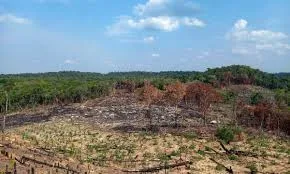As Cambodia prepares to participate in the 16th UN Biodiversity Conference (COP16), the country’s deforestation problem remains a significant barrier to conservation and climate goals. This blog post examines the current state of deforestation in Cambodia, its implications for biodiversity, and how COP16 presents both challenges and opportunities for addressing these critical issues.
The State of Deforestation in Cambodia
Cambodia, known for its rich biodiversity and lush forests, has one of the highest deforestation rates in the world. Over the past few decades, large swaths of its forest cover have been lost due to illegal logging, agricultural expansion, and infrastructure development. According to recent reports, Cambodia lost nearly 2.3 million hectares of forest from 2001 to 2020, with deforestation rates peaking in recent years. The primary drivers include:
Illegal Logging: Timber extraction, often facilitated by corruption and weak law enforcement, continues to degrade forested areas, especially in protected zones.
Land Concessions for Agriculture: Economic land concessions for plantations, such as rubber and palm oil, have led to the conversion of forested land into agricultural fields.
Infrastructure Development: The construction of roads and dams has resulted in habitat fragmentation, making it difficult for wildlife to thrive.
The rapid loss of forests threatens the survival of various endangered species, including the Asian elephant, Indochinese tiger, and the giant ibis. It also undermines the livelihoods of indigenous communities who rely on forest resources.
COP16: An Opportunity for Change
COP16, to be hosted by Colombia, is expected to bring together nations to negotiate and strengthen global biodiversity targets. For Cambodia, the conference represents an opportunity to:
1. Strengthen Conservation Policies: With international pressure and support, Cambodia can implement stricter regulations on illegal logging and enforce better monitoring mechanisms.
2. Commit to Reforestation: Engaging in global reforestation initiatives, such as the "1 Trillion Trees" campaign, could help Cambodia restore its forest cover.
3. Leverage International Funding: Participation in COP16 could open up avenues for financial support aimed at sustainable land management and community-based conservation projects.
4. Address the Impacts of Climate Change: The El Niño phenomenon has worsened droughts, leading to higher forest fire risks and compounding the effects of deforestation. COP16 discussions will likely emphasize the need for climate adaptation strategies that integrate forest protection.
Challenges on the Path to Conservation
Despite these potential benefits, several challenges remain:
Balancing Economic Development and Conservation: Cambodia’s economic growth has been partly driven by land-use changes, making it difficult to balance conservation with development needs.
Enforcing Existing Laws: The effectiveness of conservation policies depends heavily on the government's ability to implement and enforce regulations, which has been inconsistent due to corruption and lack of resources.
Community Involvement: Effective conservation requires the participation of local communities. Ensuring that indigenous and rural populations benefit from conservation efforts will be crucial for their long-term success.
Looking Ahead
Cambodia’s participation in COP16 will be a litmus test for the country’s commitment to preserving its natural heritage while pursuing sustainable development. By aligning its national strategies with global biodiversity goals, Cambodia can play a significant role in the fight against deforestation and climate change. The decisions made at COP16 could shape the future of the country's forests, wildlife, and communities for decades to come.






No comments: